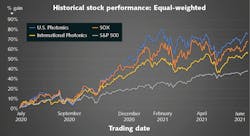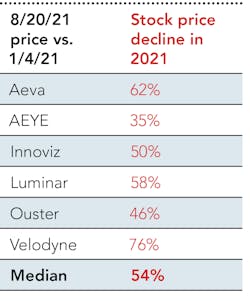Photonics stocks: Free markets vs. regulatory speedbumps
For the past year, we’ve shared how our LightWave Advisors Photonics Indices (see https://bit.ly/PhotonicsStockIndices) have been tracking in lockstep with the well-known Semiconductor SOX index (see figure). A bold but accurate statement is: the entire semiconductor sector did not, and will not, advance without leadership and innovation from the photonics sector. A great example is the case of ASML and its laser innovations that are fueling the race in buildouts of new semiconductors. ASML has tripled in value in three years and is now valued at nearly $300 billion—more than Intel.
While photonics has often been cast as a fragmented backwater of esoteric technologies, its impact is broad and deep. It deserves greater investor attention for its role in driving new products and services across the entire tech ecosystem—not just in communications, but throughout semiconductors, the Internet of Things (IoT), medical innovations, mobility, and in making artificial intelligence (AI) relevant.
The ‘speedbump” issue is that many of these market opportunities for photonics have incredibly long design-in and testing cycles, which include obstacles such as industry standards and regulatory hurdles. In communications, the obstacle for any companies in the 1990s and early 2000s was Telcordia approval cycles and costs. Raising a few hundred million dollars in private or public capital wasn’t enough for many companies of that era to survive the approval, design-in cycle, and market demand shifts. Medical device firms that are subject to U.S. Food and Drug Administration (FDA) cycles face a similarly onerous path and expense that can exhaust funds and investor appetites.
Fortunately for the communications sector, the rise of datacenters and wireless distribution coupled with the flexibility of software in managing switching and quality-of-service allowed re-architecting specifications away from Telcordia handcuffs. Optical vendors have benefited from these moves and the datacenter players have blown by the old-line telecom carriers in buildouts, influence on optical vendors, and equity market values over the past decade.
The photonics community has enjoyed the excitement of capital flows and huge future forecasts from 10 newly public lidar firms this the past year, with Cepton, Aurora, and Quanergy coming on-stream recently and more firms trying to queue up investor interest. While some of these firms are automotive- or trucking-centric as their customer application focus, others are initially focused on smart mobility for warehousing or smart-cities monitoring. All these firms project revenues to grow dramatically from the modest revenues of today in initial deployments, trials, and customer non-recurring engineering (NRE) contracts. The initial half-dozen firms that completed special-purpose acquisition company (SPAC) mergers (with each bringing in several hundred million in capital) have projected profitability in 2022 to 2024, with 2025 revenue ranging from $300 million to well over $1 billion. Yet all have suffered major stock declines in recent months (see table).Why the declines? It’s a natural question. A recent analysis by Loup Ventures, one of the stock market analysts with the longest and very insightful observations about Tesla noted an issue: the U.S. National Highway Transportation Safety Administration (NHTSA) announced on August 16, 2021, that it is beginning formal investigations into several Tesla autonomous vehicle crashes. Tesla shares closed down 4.32% the day following the NHTSA announcement. Loup Ventures commented, “Greater autonomy scrutiny for tech companies will likely delay any mainstream autonomy availability. We’ve been hoping that we’d see public full self-driving in 2025, and that’s looking to be optimistic.”
Essentially, lidar and autonomous vehicles are having their Telcordia- and FDA-like testing and vetting moments, which will take time to resolve. As in all cases involving risk of extensive damage to people and property, resolution will also come with added legal and insurance policies and costs, which will be put in place as part of the regulatory process. This means time and money, as always.
Questions for the public lidar firms are: 1) How can they navigate these speedbumps on the way to large volumes in transportation—are pivots in strategies or expectations needed, do they have the capital to go through many years of soft revenue; 2) Are non-automotive markets big enough and profitable enough to capture investors support; 3) Are non-U.S. markets better places for these firms to focus; and 4) are mergers, including with some of the electric vehicle firms to add-value-upstream, a path some might take?
I am frequently asked, shouldn’t these firms be added to the Photonics Stock Indices? On the one hand, they have brought substantial capital and new customer and supply chain relations into the photonics sector. Counter-balancing these benefits is the fact that they have demonstrated extreme volatility, which can be a drag on the broader sector stock performance measurements that are based on companies with sustainable business models and strategies. The lidar firms right now are more akin to pre-FDA approved public biotech firms, and it’s great to see how they are advancing innovation. For public investors, they are options for adding to one’s portfolio venture-type returns and risks. There will be volatility, and winners and losers—something we’ve seen before among the most promising market applications of photonics. Buckle up!
About the Author
John Dexheimer
President, LightWave Advisors
John Dexheimer is President of LightWave Advisors. He has been a past Laser Focus World contributor on business trends and investments in the photonics sector. As an investment banker, he managed the IPO of Uniphase, assisted in their early global acquisitions, and invested in and advised several other optical component firms that have since become part of Lumentum’s global business.


